Nike’s 50th Anniversary: A Celebration Of Sport & Future Sustainability
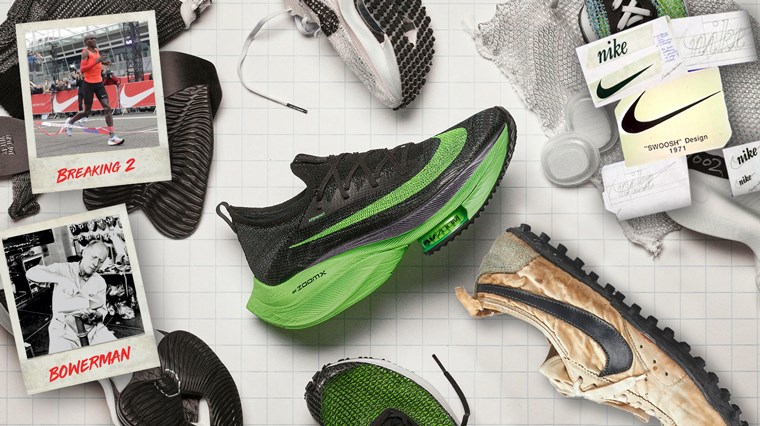
The Nike Swoosh logo is instantly recognisable across the globe. Whether on the feet of elite athletes like Eliud Kipchoge as he lived his dream to break the 2-hour marathon barrier, or worn as a mark of pride on the running shoes, sneakers and clothing of everyday athletes, the Nike Swoosh is here to stay.
Nike believes everyone deserves to experience the joy of movement – starting from inspiring kids to become future athletes with Nike’s ‘Made To Play’ program, to applying their research and ingenuity to continuously evolve sportswear and keep you on track of a lifelong fitness journey.
On the 30th of May 2022, we celebrated half a century of Nike. To mark the occasion, we’re going to dive into Nike’s past, present and future initiatives including the origins of the Nike Swoosh, Nike’s step in the right direction to ‘Move To Zero’ for sustainability and their commitment to “Bring inspiration and innovation to every athlete* in the world”.
About Nike
Nike is a brand created by runners, for runners.
Their mission is to increase human potential through innovations in sportswear and to connect to athletes across the globe, building a community that focuses on a shared passion and respect for the power of sport.
What we love most about Nike is their belief that “*if you have a body, you are an athlete” – a phrase first said by track and field coach Bill Bowerman, co-founder of Nike.
Nike’s Past: Determination & Innovation
1964: Blue Ribbon Sports Is Founded
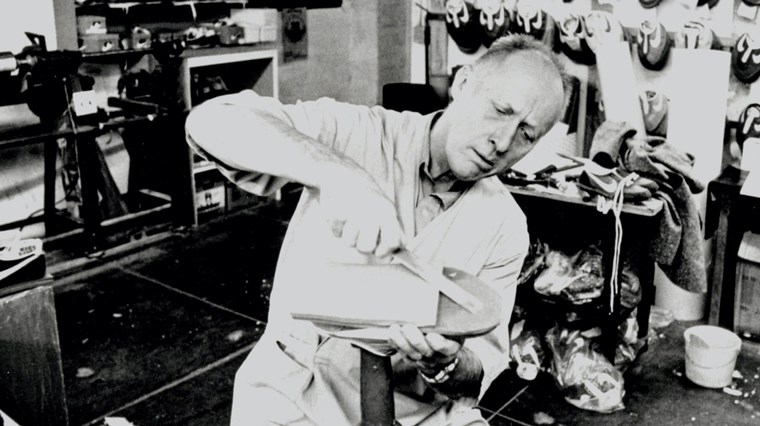
To understand Nike’s origins, let’s take a step back in time. Kick-starting in 1964, Nike’s founding company Blue Ribbon Sports was given life by track athlete Phil Knight of the University of Oregon and his coach Bill Bowerman (above).
Even before Blue Ribbon Sports, Bowerman would modify running shoes, with a focus on speed and shock-absorption in a lighter weight package. Blue Ribbon Sports recognised a gap in the market for affordable yet performance-driven shoes to compete with the currently dominant brands, Adidas and Puma.
Blue Ribbon Sports began by selling imported shoes from Japan in the US, developed by Onitsuka Tiger (currently Asics), a collaboration that wouldn’t last. Selling shoes out of the boot of his car, Phil Knight chased opportunities to connect with coaches, runners and supporters at track meets. Phil Knight’s belief in the products fuelled sales.
In 1965 salesperson and running enthusiast Jeff Johnson joined the team full-time, selling 3,250 pairs of shoes in only 10 months. Johnson personalised the experience for customers, noting down their shoe size, shoe preference and running distance – much like Sportitude Running does in our RunDNA shoe fitting service to find the best running shoes for you.
With correspondence through mail, Johnson stayed in contact with customers who shared their running journeys with him – from big successes to injuries. He’d even on occasion adapt the shoes to fit the customer’s needs, until he built not only a healthy customer base, but loyal fans from coaches to running clubs.
Running as a recreational activity boomed in popularity with Bowerman’s release of a book titled “Jogging” in 1966, further fuelling the success of Blue Ribbon Sports, and they opened their first retail store in the same year.
1971: Nike Is Born
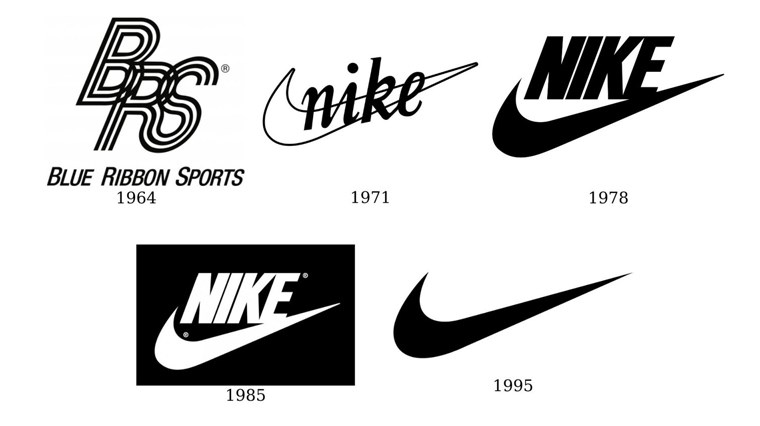
Fast forward to 1971, Blue Ribbon Sports had cut their ties with Onitsuka Tiger and began designing their own shoes with a focus on performance with low production costs and a budget-friendly price point to get them on the feet of real-world runners.
Blue Ribbon Sports officially rebranded as Nike on the 30th of May 1971, named after the Greek goddess of victory - an idea that came to Jeff Johnson in a dream. The Nike Swoosh logo itself was designed by graphic designer Carolyn Davidson, inspired by the wings of the goddess and featuring an arc shape that symbolises speed and motion.
What were Nike co-founder Phil Knight’s thoughts on the logo? “I don’t love it, but maybe it’ll grow on me”. Half a century later, the Nike Swoosh has certainly made its mark as one of the most iconic logos in the world.
Phil Knight, co-founder of Nike:
"I remember thinking, 'This is it - this is the moment. This is the moment we've been waiting for. Our moment. No more working for someone else. If we're going to succeed or fail, we should do so on our own terms, with our own ideas, with our own brand.' And just like that, Nike was born."
The Nike Waffle Trainer
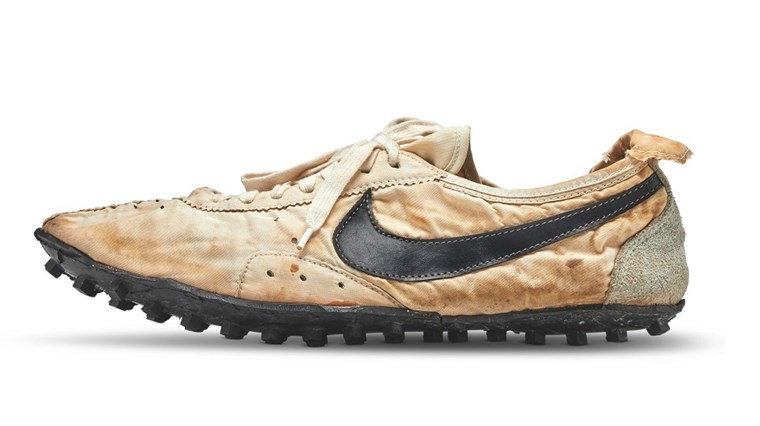
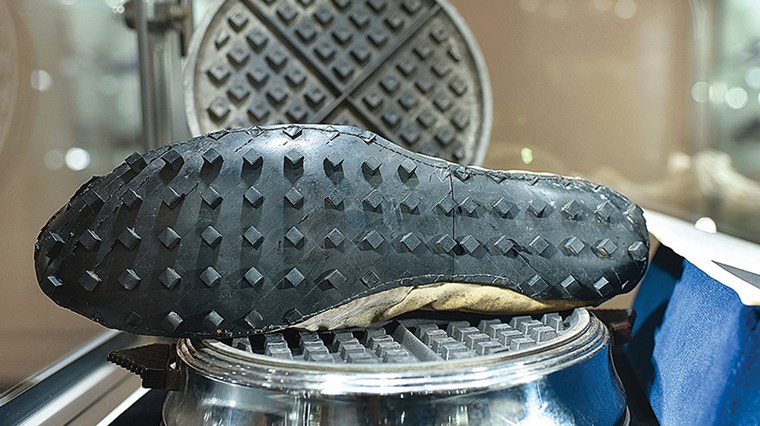
In the early life of Nike, Bowerman was passionate about inventing a lightweight, spikeless sole that would provide high-speed traction and reduce risk of blisters, increasing the performance potential of athletes.
In a lightbulb moment in 1971, he realised the family waffle iron would make an ideal mould for a grooved outsole and after some experimentation, one of Nike’s most iconic shoes, the Waffle Trainer was given life. The waffle outsole we know today was literally inspired by breakfast!
The Waffle Trainer was first released in 1974. Nicknamed the ‘Moon Shoe’ for the imprint it left in the ground that resembled that of astronauts, the Waffle Trainer offered the cushioned feel that runners craved and that would be game-changing for decades to come.
Bill Bowerman, co-founder of Nike:
"A shoe must be three things. It must be light, comfortable and it's got to go the distance."
Nike’s Present: Breaking Barriers
Currently, Nike is a sportswear empire and it’s unlikely you’ll step outside without seeing the iconic Nike Swoosh on clothing, running shoes or sneakers, including vintage-inspired styles that give a nod to Nike’s origins. Nike’s “Just Do It.” slogan that launched in 1988 continues to motivate athletes of all abilities across the globe.
Nike's Breaking2 Project & "The Shoe That Started A Revolution"
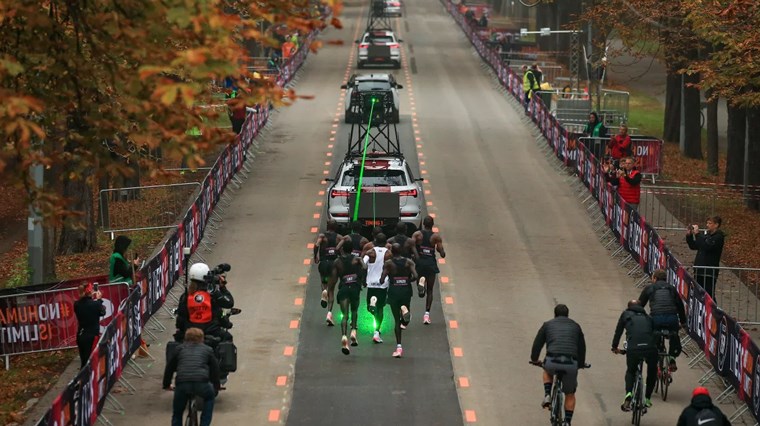
In recent years, Nike have solidified their part in the future of running, with projects like Breaking2 which led to Kenyan long-distance runner Eliud Kipchoge successfully completing a marathon in under 2 hours in 2019.
The road to his success wasn’t an easy path – it took years of commitment, preparation and perseverance. Wearing the Nike ZoomX Vaporfly 4% which was engineered specifically for this task, his first attempt to conquer the 2-hour marathon barrier was on the 6th of May 2017 in Monza, Italy. He crossed the finish line in 2:00:25 - just 26 seconds away from his ambitious goal.
The carbon-plated Nike ZoomX Vaporfly 4% which Nike refers to as “the shoe that started a revolution” was made in partnership with the Nike Sport Research Lab and Kipchoge – putting the demands of the real-world athlete into action. With Nike's innovative engineering, carbon-plated running shoes had made their mark on the racing world, with the Nike ZoomX Vaporfly 4% and the Breaking2 project inspiring runners across the globe.
Nike’s goal was to maximise human potential through innovation in sportswear - but they weren’t quite there yet.
After Kipchoge’s attempt in 2017, every detail was again put under scrutiny – from nutrition and hydration, the location of the marathon (Vienna, Austria was eventually chosen for its time zone and temperate climate) to every aspect of the shoe itself.
Putting a fresh spin on fast, it was the prototype of the entirely new and ground-breaking Nike Air Zoom Alphafly Next% that Kipchoge would wear when achieving his dream on the 12th of October 2019 as part of the INEOS 1:59 Challenge (pictured above and below). He completed the marathon in a jaw-dropping time of 1:59:40 – the fastest marathon time ever.
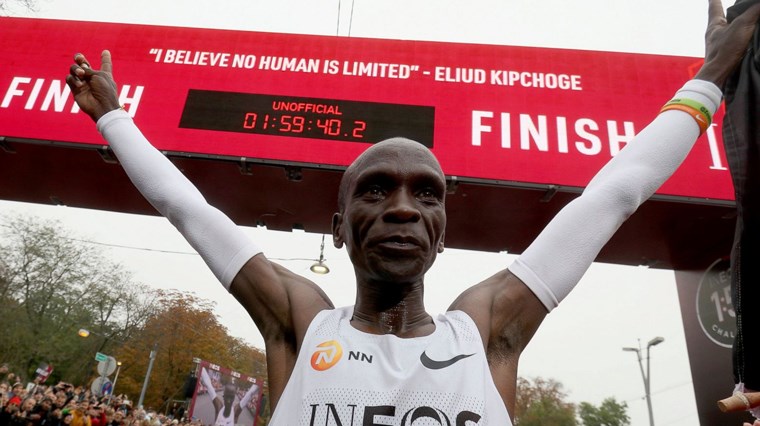
The pioneering Nike Air Zoom Alphafly Next% would cement Nike's legacy and passion for innovation as their flagship marathon shoe. The revolutionary technologies of the prototype were transferred over to the completed version of the racing shoe. In it's current form, the Nike Air Zoom Alphafly Next% outruns its competitors with a featherlight AtomKnit upper, weight-saving and responsive ZoomX foam and 2 visible Zoom Air pods in the forefoot for more effortless and explosive propulsion.
Alongside it, the Nike ZoomX Vaporfly Next%, an evolution of the Nike ZoomX Vaporfly 4%, would go on to top podiums in years to come. Both the Nike ZoomX Vaporfly Next% and Nike Air Zoom Alphafly Next% surpassed the energy return characteristics of the racing shoe that started it all, as Nike continuously pushed the limits of what was perceived possible in human achievement.
Nike made these revolutionary carbon-plated shoes available for purchase, so you can wear these heroes of history to elevate your performance and running efficiency.
This athletic victory is seen as proof of that when science and innovation are coupled with passion and commitment, humanity is virtually unstoppable or as Eliud Kipchoge said:
“No human is limited.”
Made To Play: Inspiring & Supporting Little Athletes
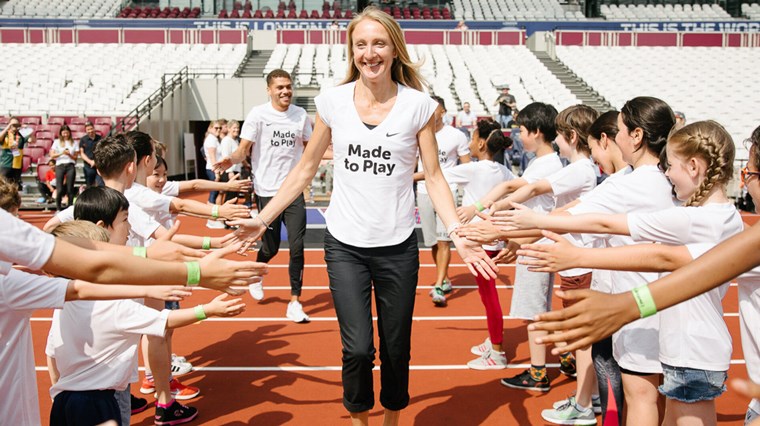
From supporting record-breaking athletes to inspiring kids to move, Nike is paving the way for the future of sport. Nike has been supporting kids to stay active with their Made To Play campaign - encouraging growth and discovery through movement and building the foundations for kids to enjoy the physical and mental benefits of sport later in life.
Studies suggest that by age 14, girls drop out of sport at double the rate of boys and according to Suncorp's Australian Youth & Confidence Research 2019, by age 17 nearly 50% of girls give up on sport entirely. The Made To Play initiative focuses on breaking barriers for young female athletes (aged 7-13 years old), providing opportunities to participate in sport, compete and to develop healthy relationships with their coaches.
In the Women’s Sports Foundation and Nike’s Coaching Through A Gender Lens report, the power of having a supportive coach was highlighted as a key factor in girls developing positive associations with sport. Nike turned this research into education by developing the Made To Play Coaching Girls Guide. It’s not just about training coaches – but educating parents, teachers and all adults that care about our kids’ futures. In this way Nike have reached beyond their roots as a sportswear brand, to inspire and instigate change in the way we think about sport.
By celebrating progress and bravery in sport rather than the end goal, Nike have helped create an environment where trying rather than winning is rewarded to empower young athletes. Through making sport fun, girls are more likely to stick to it, develop lifelong confidence through social bonds made on the court or pitch, and grow as future leaders and changemakers.
Nike’s Future: Just Do It.
Where will sport take us in 50 years? We can’t say for sure, but without a doubt Nike will be there. It’s fun to speculate the potential for a marathon on the moon, but Nike’s vision is to protect our beautiful blue home to preserve the future of sport right here on Earth.
A Step Towards Sustainability: Move To Zero
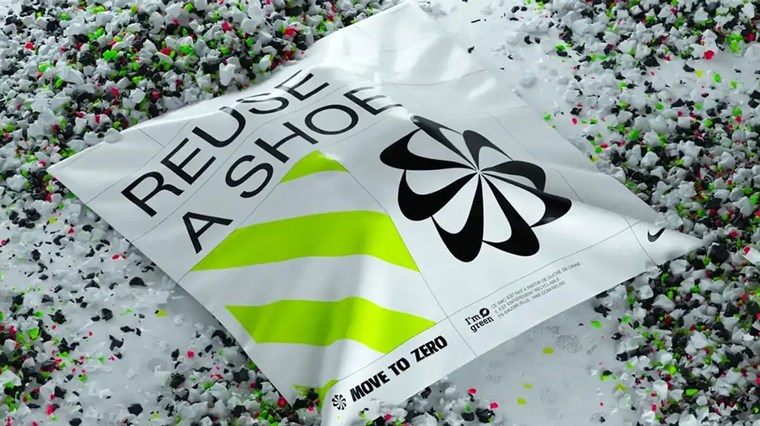
Nike believes the move to a better future starts now. Using scientific solutions to address environmental issues, Nike are putting more sustainable manufacturing practices into play. As a sportswear giant, Nike’s commitment to sustainability will make a dramatic dent in reducing their carbon emissions and preserving valuable resources for years to come.
Unveiled in 2019, Move To Zero is Nike’s sustainability campaign designed to “help protect the future of sport” by supporting the health of our planet. The overall goal is to produce zero carbon and zero waste, with key targets including to run on 100% renewable energy by 2025.
The ingenuity through research that Nike have shown towards their sustainability initiatives is comparable to their epic feats like the Breaking2 project – where their perseverance has opened possibilities in the face of a challenge which at first may seem insurmountable.
Taking responsibility for all stages of product development, including diligence regarding carbon, energy, water and waste on a smaller scale, can have a giant influence up the chain when considering the bigger picture of Nike’s overall impacts.
Giving ‘Waste’ A New Life
Across the span of over a decade Nike have repurposed billions of plastic bottles (on average 1 billion bottles annually), giving them a new life as premium sportswear and keeping them out of landfill and our oceans. These bottle-based recycled yarns put a fresh spin on how we view discarded materials – seeing value instead of waste and helping make virgin polyester history.
Nike’s Flyknit technology used in many of their running shoe uppers and Nike Air soles are among the hero materials that are making a difference from heel-to-toe by reducing wastage and putting recycled fibres into action.
In 2021 Nike gave their fastest marathon shoe an eco-friendly spin, unveiling the Nike Air Zoom Alphafly Next Nature. Putting 'waste' to work, it features the technologies of the Nike Air Zoom Alphafly Next% in a more sustainable package. In fact, it is the most eco-friendly performance shoe from Nike yet, with a minimum of 50% recycled content based on weight.
Nike Grind material is another step towards sustainability. Nike takes manufacturing scrap (e.g. fabric off-cuts) and post-consumer shoes that have lived a life well-run and turn them into new products. It’s the ‘circle of life’ for sportswear by reusing and recycling for a better future. Alongside sportswear, Nike Grind materials are used to create furniture, playgrounds, basketball courts and more to support sustainability from the ground up.
As of 2021, roughly 78% of all Nike products were made in part with recycled materials. Keeping in mind that about 70% of Nike’s carbon footprint is attributed to their choice in materials, this is a healthy step in the right direction.
What does climate change mean for the future of sport?
Sport is at the heart of Nike, and there’s no doubt the current trajectory of climate change will have negative ramifications on sport, let alone the planet. Nike have set the bar high with their sustainability targets for 2025 to tackle climate change and we're cheering for them to succeed and inspire other leading sportswear brands to follow in their footsteps.
Research suggests that since the 1980s, there has been a 25% increase on average worldwide in the number of days that are above 32.2°C (90°F). Competing and training in rising temperatures is dangerous and detrimental to performance - forcing athletes in parts of the world, particularly in cities close to the equator, to rethink how they train, what they wear, the duration of practice sessions and even resulting in the cancelation of matches for safety’s sake.
To put this in perspective, studies on participating athletes during the Breaking2 project suggested the sweet spot in temperature to achieve the fastest race times was 10°C (50°F). When Eliud Kipchoge broke the 2-hour marathon barrier in Vienna in 2019, the temperature was about 9°C.
As the mercury climbs, these leaps in athletic potential may be further from our reach. Severe heat increases stress to the body, the risk of injury and potentially slows down recovery. For athletes in snow sports, the ground on which to train and compete is literally decreasing as a consequence of climate change.
Nike’s commitment to continuously progress in their sustainability initiatives, challenging themselves to never settle, to find research-based ways to waste less and reuse more have earned them the nod of approval by recreational and elite athletes across the globe.
We look forward to following Nike’s sustainability journey as they support athlete’s to put their best foot forward by offering more sustainable sportswear - helping future generations and protecting sport for the decades to come.
Happy running!
